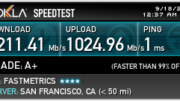The other day I was shopping and I ran across a 512GB solid state drive from a reputable manufacturer for about $50. The part of me that still thinks in 1985 terms was utterly totally floored. Back then, there was only about 512GB of data stored on the entire planet! What’s more, a ONE MEGABYTE hard drive was $1,000 in those days. With a little time spent on a calculator, I can figure out that I would have paid roughly $1.527 BILLION for that amount of storage back then, and it would have been in the form of large, clunky, mechanical hard drives. This is a silent, stable, memory stick that not only has no moving parts but is about the size of a postage stamp.
Let’s back up a second.
Mechanical hard drives
Wikipedia tells me that the first mechanical hard drives were created in 1957. Certainly by the early 1970s they were commonplace in large computer installations. By the early 1980s, standalone hard drives were available for the personal computers of the day. We called them “Winchester” drives for whatever reason. But, it wasn’t until the 1980s that internal hard drives became common. That’s when companies like Seagate and Rodime, both of which were based near IBM’s Boca Raton FL headquarters, started making what we used to think of as “cheap” hard drives. In 1990, it was common to be able to get a 40MB hard drive, large enough to run Windows, for under $250 ($600 today.) Considered plenty big back then, today that would hold about 6 songs or 1 fairly short video.
Once the basics of internal hard drives were established, it then became a game of slow and continual improvements. As components got more reliable, it became possible to store more and more information on the same size device. A number of tricks were invented to keep the hard drive race humming for decades.
By the early 2010s, it was common to see hard drives with 512GB storage capacity, equal to that $50 SSD today. Of course they were quite a bit more expensive than $50, and they were about the size of a paperback book. Drives kept getting bigger, but most folks didn’t care because they started moving to cloud-based storage. At the same time, true solid-state drives began to emerge.
What is a solid-state drive?
At its most basic, a solid-state drive is a computer chip that doesn’t lose its mind when the power is shut off. The first devices of this sort were “flash drives” or “thumb drives” which you may remember having in the 2000s. This technology replaced floppy disks and burned CDs in the days before it was possible to send large files electronically.
The problem with those early flash drives was speed. Prices went down, capacities went up, but the basic construction of this sort of device kept it from being able to read or write quickly.
True solid state drives designed to replace mechanical hard drives started appearing in the 2010s. Generally speaking they were about four times more pricey than equivalent mechanical hard drives, but they were built for speed. A typical solid state drive could be ten times faster than a mechanical hard drive, use less power, and be more reliable. The technology exploded in popularity because of its use in smartphones and tablets, and is now the standard form of internal storage in new consumer devices.
So what of mechanical hard drives?
If you want a truly insane amount of storage in one device, you’re still going to look for a mechanical hard drive. Solid state drives today top out at about 8TB, or 8,192GB if you want to think about it that way. And those drives are pricey — you’ll pay over $1,000 for a reliable one. You’ll pay just over $120 for a mechanical hard drive of that capacity. Mechanical hard drives are available commonly in 16TB sizes and the largest ones top out at about 24TB. Now folks, I have been producing videos for over a decade and I’ve only managed to create about 12TB of content in that time. I’m sure there are industries where you need 24TB of storage and more. But for most folks that’s an insane, unattainable amount of data right now. That will probably change in the future, but who knows.
So that’s why I’ll say that for consumers, yes mechanical hard drives are a thing of the past. Solid state drives are cheap enough that the average person can get all the storage they’ll need for well under $100. But mechanical hard drives still rule when you need ridiculous amounts of storage. If you’re James Cameron and you shoot everything for your movies in 8K IMAX, you’ll need them. If you’re a large data center where storage speed is less important than storage space, you’ll need them. But for regular folks, it’s time to put that tech out of your mind.
Solid state drives are better for now, but will they last?
Solid state drives are easier to manufacture using chipmaking techniques used all over the world. They’re generally more reliable because they have no moving parts. The only thing we don’t truly know is how well they’ll hold up over time. Every time a new storage technology comes out, it’s touted as “permanent storage.” But, we now know that CDs rot, all forms of magnetic storage degrade, and even fancy stuff like holographic storage can turn to dust over time. With no moving parts, solid state drives should last for decades. But in the end, who knows? Good old mechanical hard drives are still considered more reliable just because we know how they react over time.
But unless you’re really worried about decades-long storage, here’s your answer. Yes. It’s time to say goodbye to those humming, clicking, vibrating mechanical hard drives.





